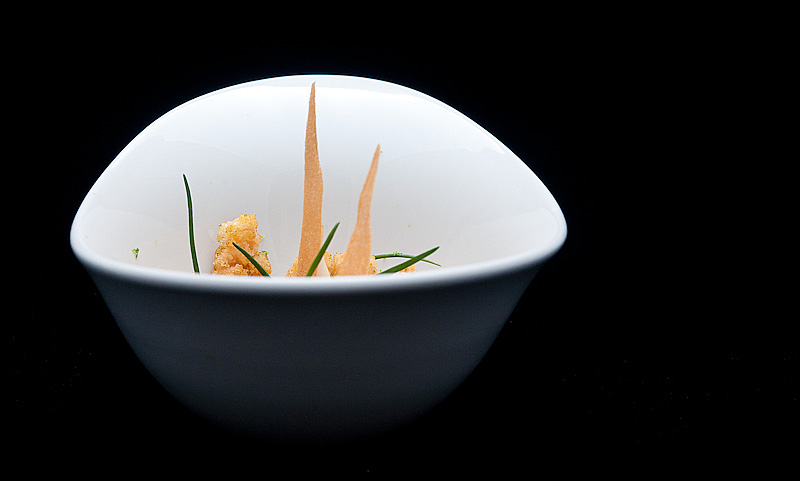
Before I get going on this one I’m issuing a disclaimer: this story will be presented in a Choose Your Own Adventure-style format. There’s a fairly important thing I ran into here in my insistence of understanding where my food comes from that I find fascinating, but I worry some might find objectionable. To avoid causing undo stress to anyone reading this casually, I’m sequestering a section of this adventure on a completely different area of this site so no one runs across it inadvertently. When the time comes, you can decide how much you’d like to learn.
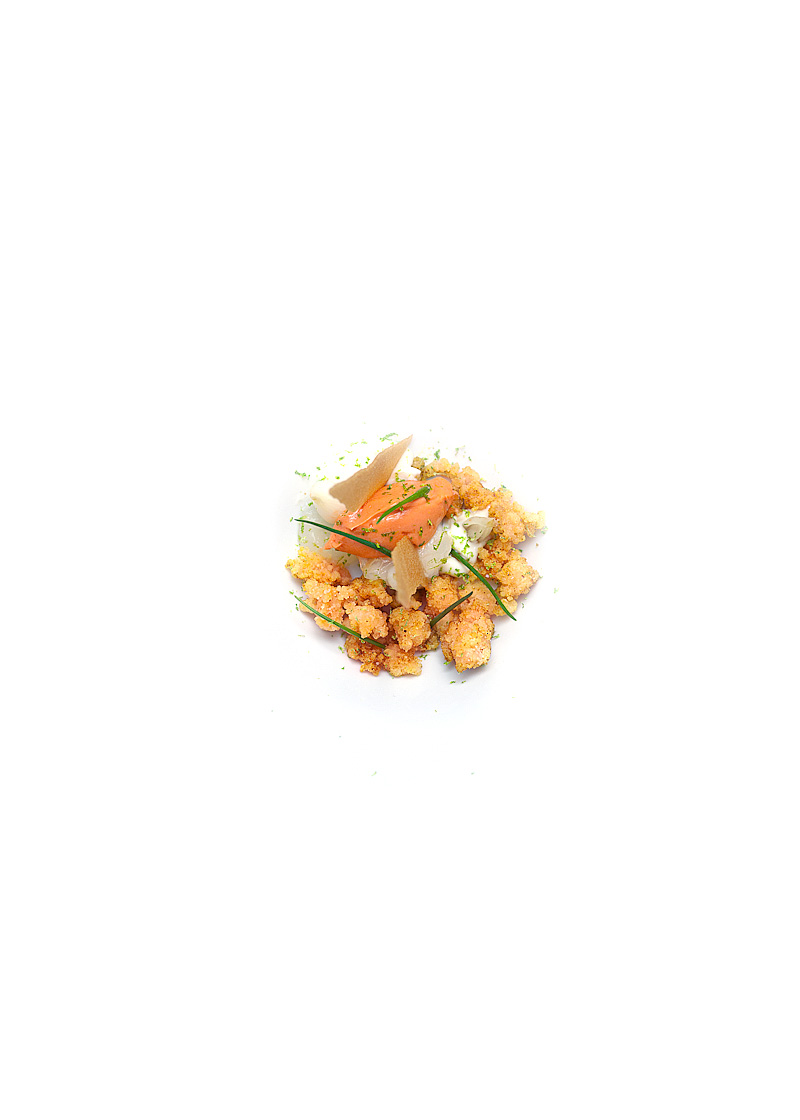
What is a Monkfish? The gentleman’s answer is that it’s a type of anglerfish; this means that it has a funky little modified spine as part of it’s dorsal fin that it can move around in multiple directions. This modified spine is called an illicium and it terminates in a small irregular growth of flesh called the esca. The Monkfish uses this spine as a biological fishing rod. The fish is quite flat — sort of like a ray — and burrows into the sea bed, where it waves around it’s spinal fishing rod to bait in unsuspecting prey. The mechanics of the Monkfish’s massive jaw are tied to nerves in the esca; when something stimulates it the jaws snap shut on the prey as a reflex rather than a conscious decision.
The real-world person’s answer is that it’s assuredly a terrifying devil-monster sent to fuel the nightmares of any creature to cross it’s path. Look at this fucking thing:
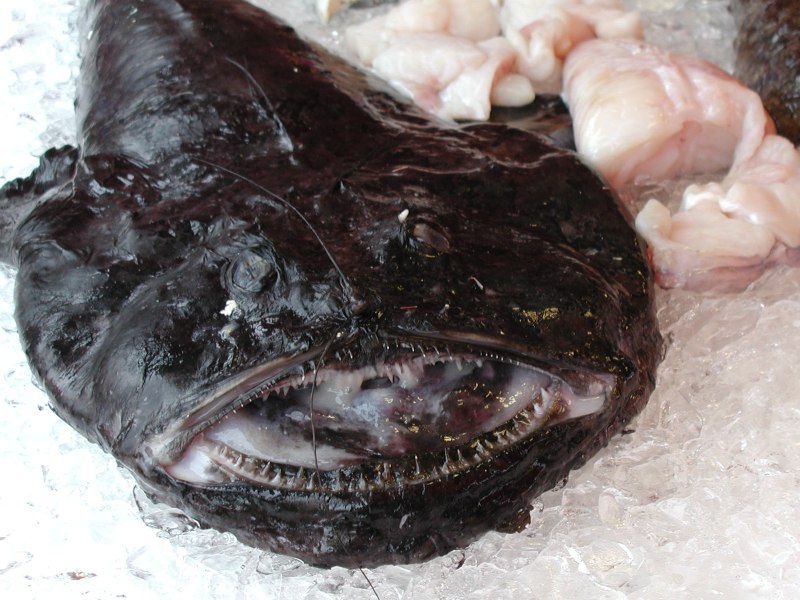
For this recipe, one is meant to procure and make use of at least 2 whole monkfish. I worked for a couple of weeks trying to track such a thing down; Monterey Fish in Berkeley was open to helping me, but warned that wholesale cost of a whole monkfish is around $100 a pop. The bulk of the interesting meat in the monkfish (and what the recipe calls for) are the “loins”, or fillets that lie on either side of the monkfish’s cartilaginous spine in its tail. Also interesting is the monkfish’s liver, an enlarged organ bigger than a human hand that’s prized as being very similar to foie gras in taste and texture (it’s seen frequently in Japanese cuisine, where it’s usually soaked in sake, steamed, and served sushi-style as “Ankimo”). The rest of the fish is mostly bone/skull, which in this recipe is cooked into a flavorful fish stock.
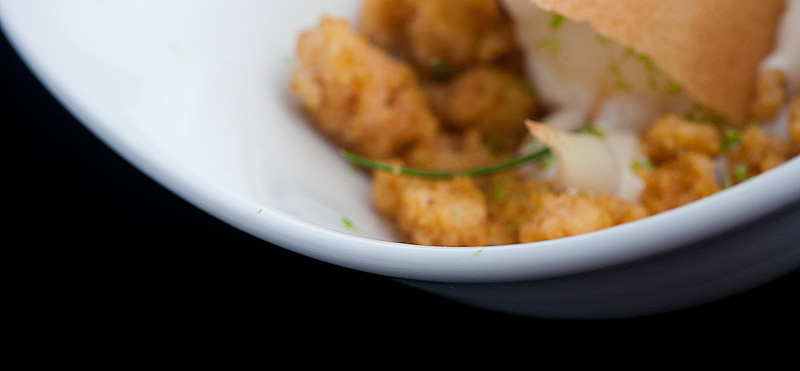
Monterey advised that I might be better off buying the fish pre-butchered (as it often is at the fishing wharf) and get only the minimum of what I need (which was the liver, the tail, and an estimated 2lbs of bones). I placed an order with them for pickup on the Saturday I planned to cook this dish, only to have them call me that morning to tell me that none of it had come in.
Because I like to hedge my bets, I had also placed a similar order at the well-reputed Tokyo Fish Market in Berkeley, at which I’d seen monkfish tails and liver before and made a mental note of. Thankfully, they came through, and so I drove up to visit them to buy a whole large monkfish tail along with a fresh, raw monkfish liver.
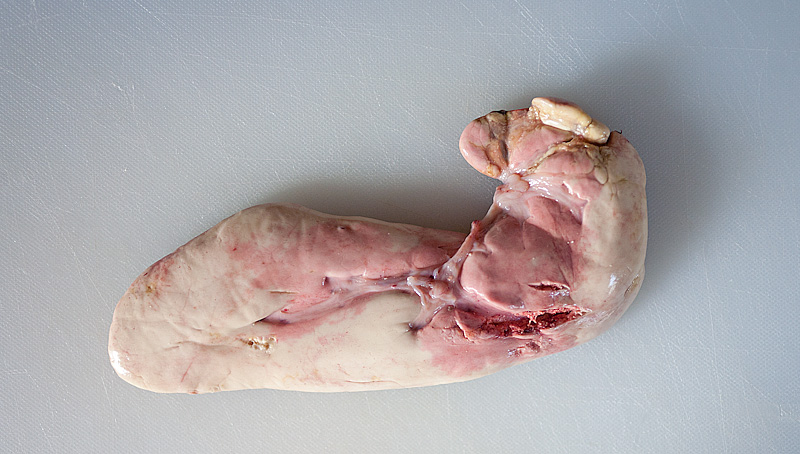
The liver was rinsed in cold water for about an hour, then left to soak overnight in whole milk; this soak is designed to mellow out the otherwise-strong flavor of the fresh liver. I stored the tail in the fridge to break down the next day, then got to work on all the rest of the components for this dish.
I cut some onions into quarters and brought them to a low simmer with some water for several hours, until they went from this:
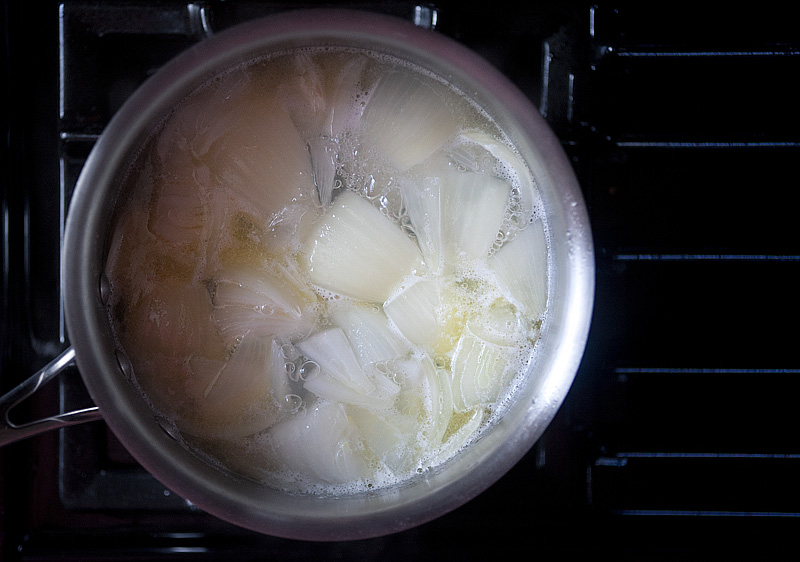
To this:
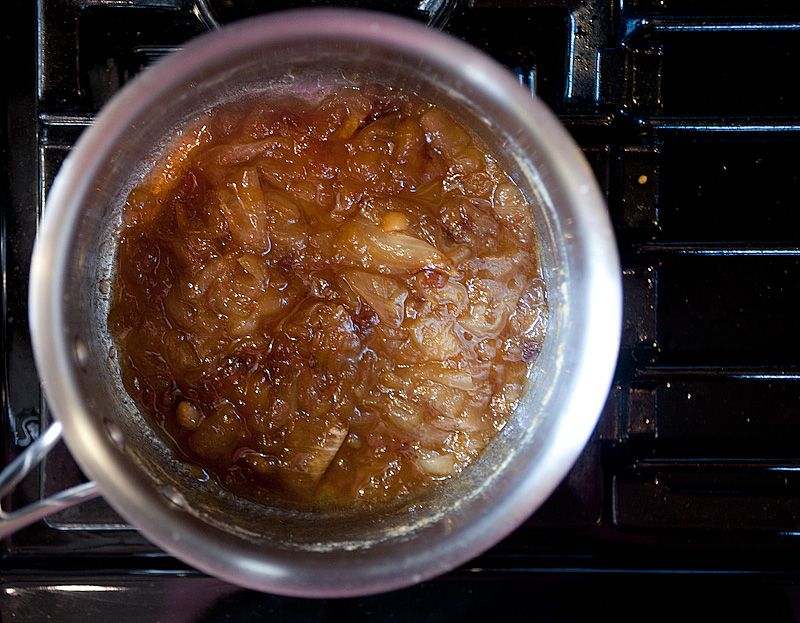
The caramelized onions were pureed, then spread on a dehydrator tray to dry for several more hours into crispy caramelized onion ‘chips’.
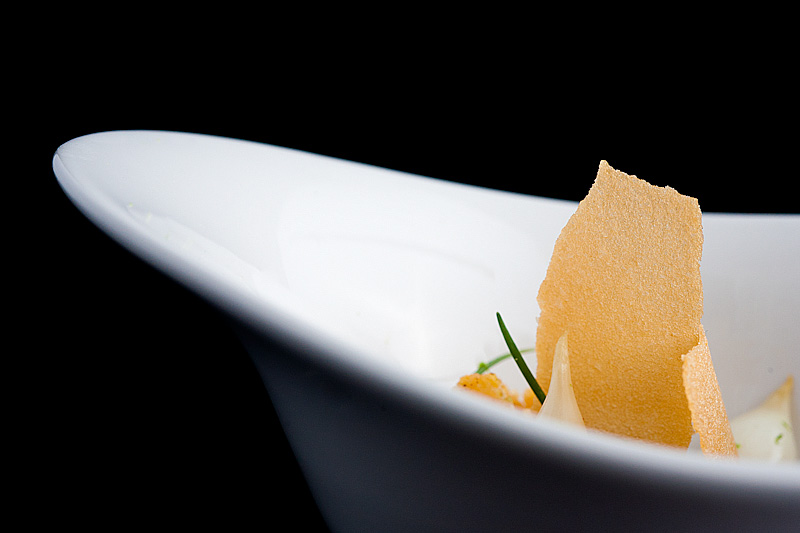
While the onions were drying, I set out some butter to soften at room temperature. A small bit of this was cooked with shallot, lime zest, bay leaf and toasted coriander briefly, then set aside to steep. This mixture was mixed with the rest of the softened butter to yield “Aromatic Butter”, which would later be used to cook the monkfish loins in en sous vide. This stuff smelled/tasted really lovely, and I wasn’t annoyed at the large portion of it that went unused, as I can use this to cook lots of other things.
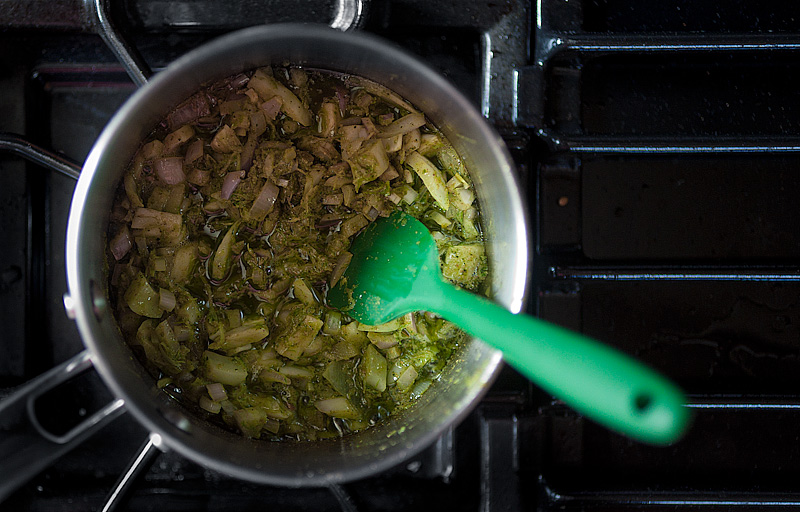
The dish is accessorized by two ‘puddings’, first is a Banana Pudding, made by steeping dried banana chips in cream until infused, then gelling the cream with Agar and blending into a pudding. The proportion of Agar called for by this recipe seems suspiciously high; the resulting banana gel is so firm it’s almost impossible to puree. It comes out sort of like a funky crumbly feta/cream cheese mixture rather than a smooth pudding. I’ve lost count how many times in this book the agar use seems wrong and I have to remake something using a more-reasonable proportion.
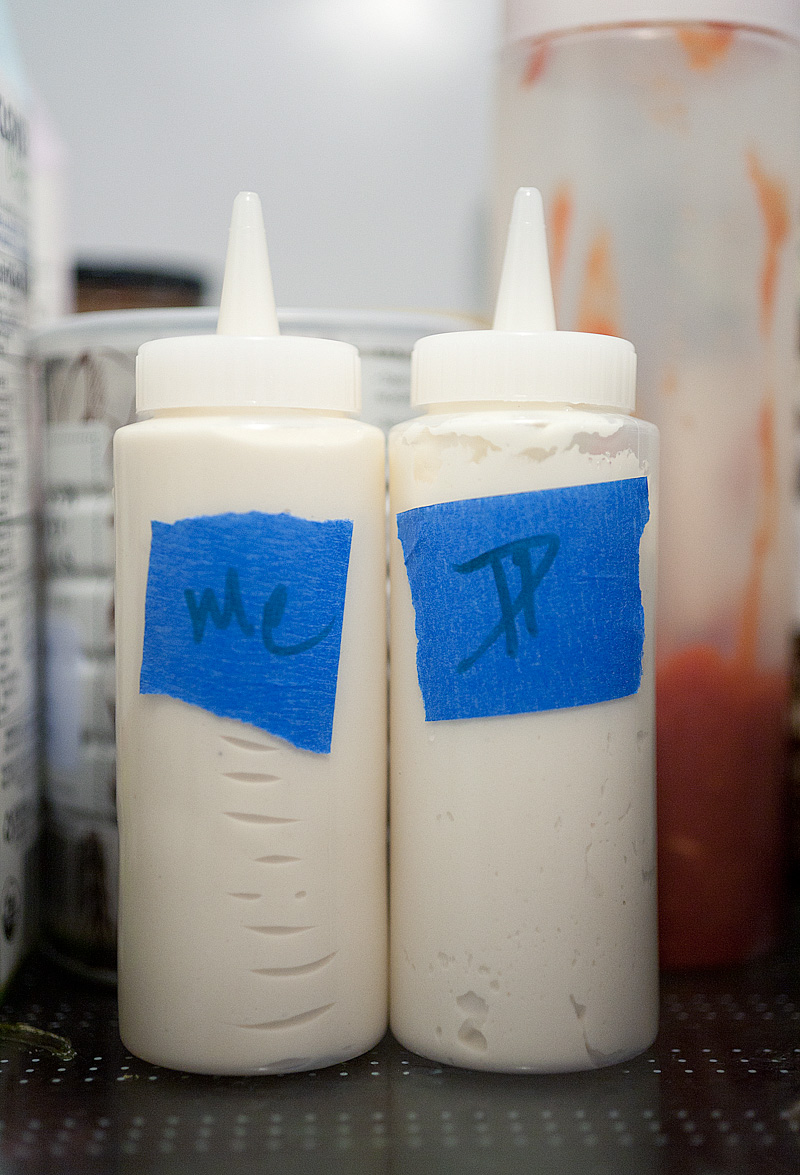
The other is a Lime Pudding, made by first steeping lime zest in water/sugar, then gelling the mixture with more Agar (which, again, was used in too-high a proportion and wouldn’t puree. Seriously, this is hella annoying. Every damn time). To fix it, I added enough lime juice to the blender as it was running for it to hydrate and form a smooth pudding.
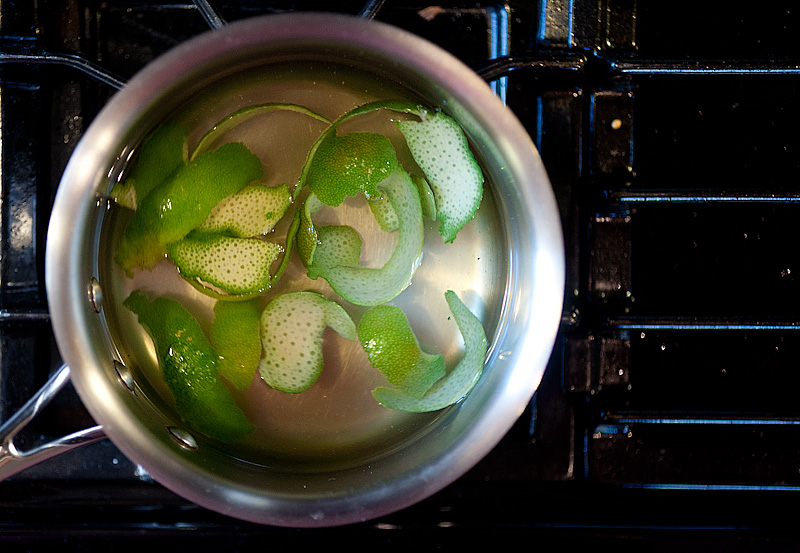
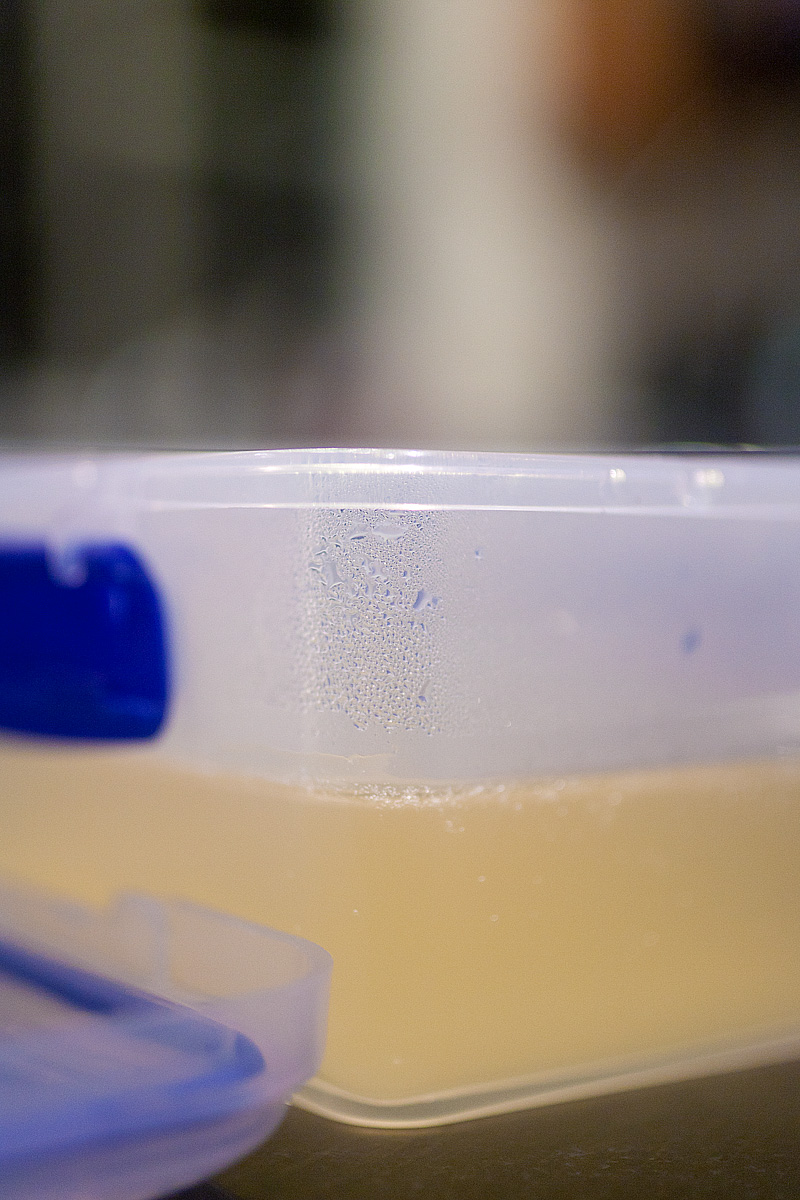
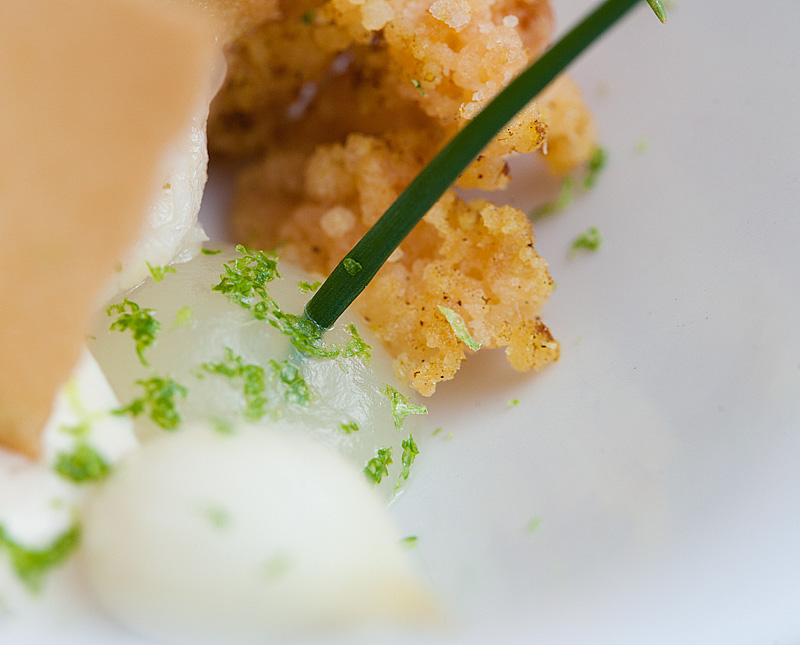
One component is meant to be “pickled ramps”, but ramps aren’t quite in season here yet, so I opted for milder small white onions, which I pickled in a mixture of white wine, white wine vinegar, sugar and salt. I love Alinea’s way of pickling things; it’s fast and mildly pickley and so yummy.
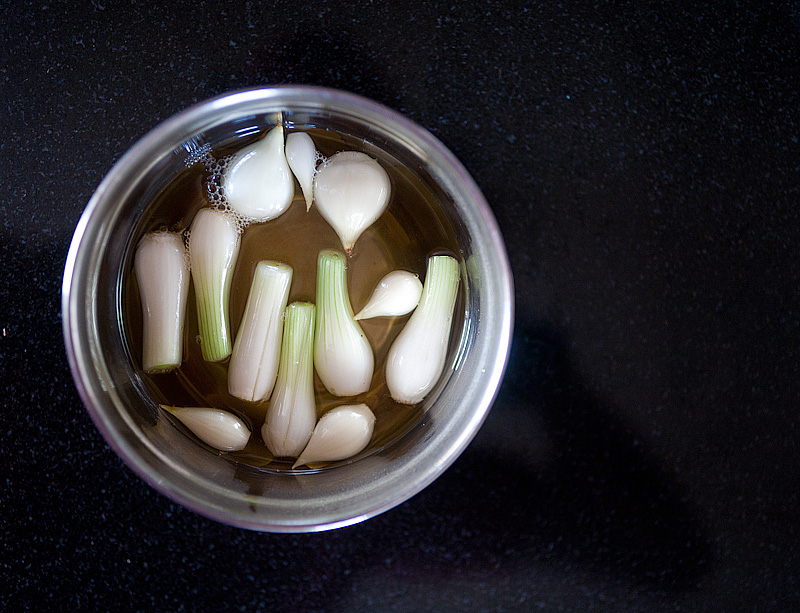
The next day, I got to work on the monkfish itself. Because I was a little terrified of this thing, I watched a couple youtube videos about filleting monkfish tails until I felt comfortable enough to give it a shot. Here’s the tail as I bought it from Tokyo Fish market…it’s about as long as my forearm.
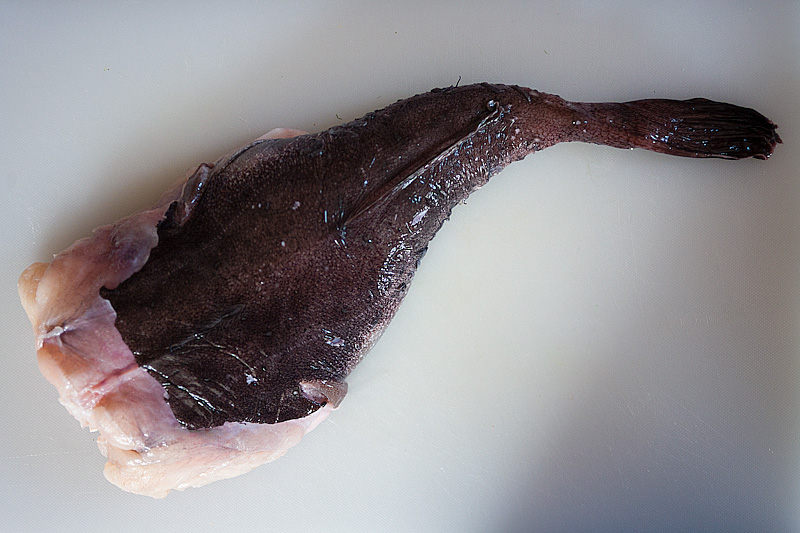
The first step was to remove the skin, which can be peeled off to yield this.
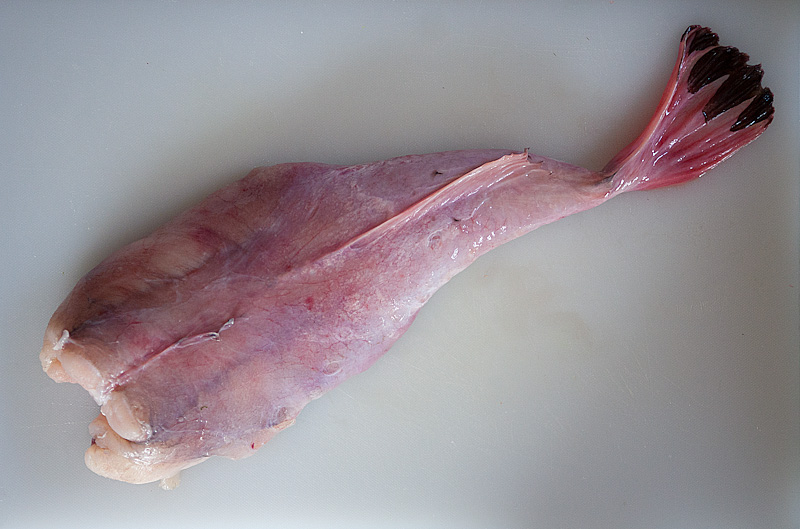
Next step was to carefully remove the “silverskin”, which, if cooked, turns tough and rubbery and isn’t pleasant to eat. I did this carefully with the aid of a fillet knife until I had this.
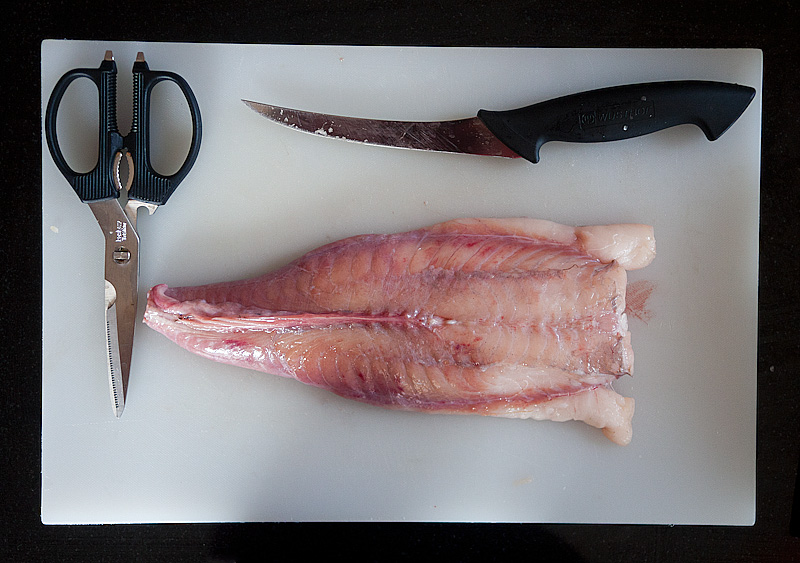
It was at this point that I noticed something that I should have been paying closer attention to but hadn’t, and it’s now that you get to exercise your own sagacity. My monkfish highlighted a need for vigilant awareness when it comes to food safety, and sent me on a side adventure on which I learned a lot more about this than I bargained for.
I can elaborate on this clearly and with photos, but it’s not for the squeamish. If you’re interested in learning more, please step right this way.
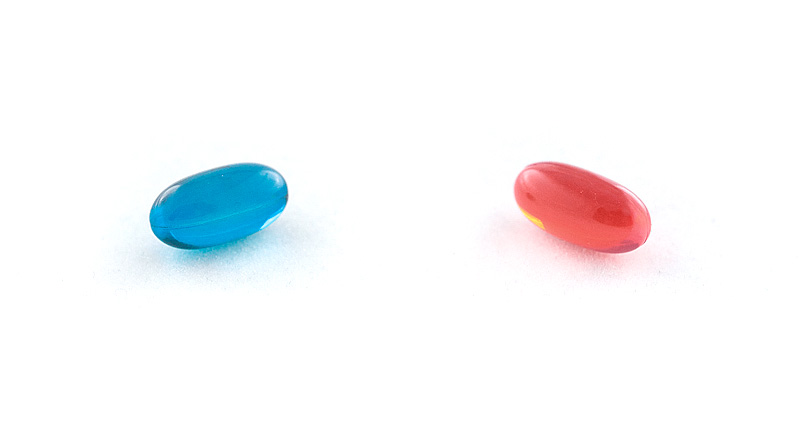
The last step was to remove the two side ‘loins’ from the central spine. The spine itself was cut into small pieces for stock, which I got to work on next.
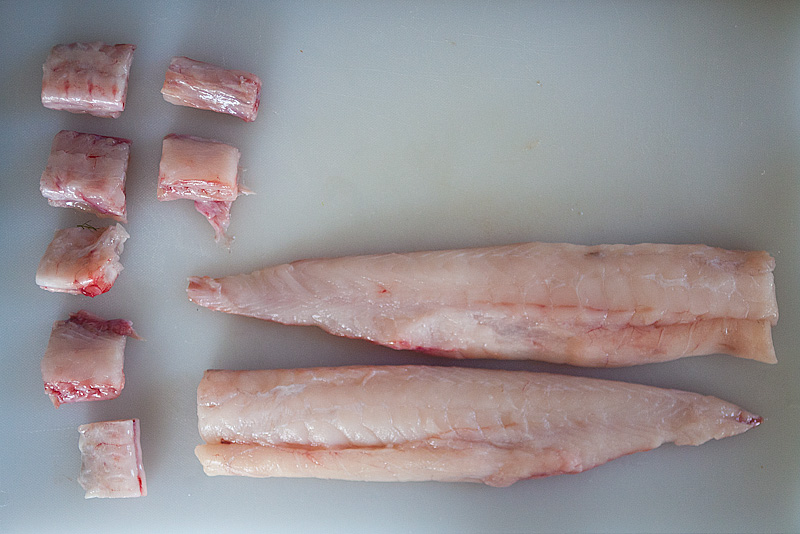
I removed the liver from the milk bath, then wrapped it tightly in cheesecloth and poached it in a warm water bath for an hour. At the same time, I worked on what the recipe called “Monkfish Mousse Base”, which is a cream-based fish stock. Since I didn’t have the two monkfish heads I would have had if I’d bought two whole fish, Tokyo Fish Market suggested I could substitute whitefish bones, which they were happy to sell me 6lbs of for $3. Specifically Rock Cod heads and carcasses, I rinsed and cleaned these then simmered them along with the monkfish spine in a mixture of half and half, cream, fennel, shallot, and various herbs to yield something that tasted almost exactly like Campbell’s New England Clam Chowder, which I’ll admit I find delicious. It was rich and complex and tasty.
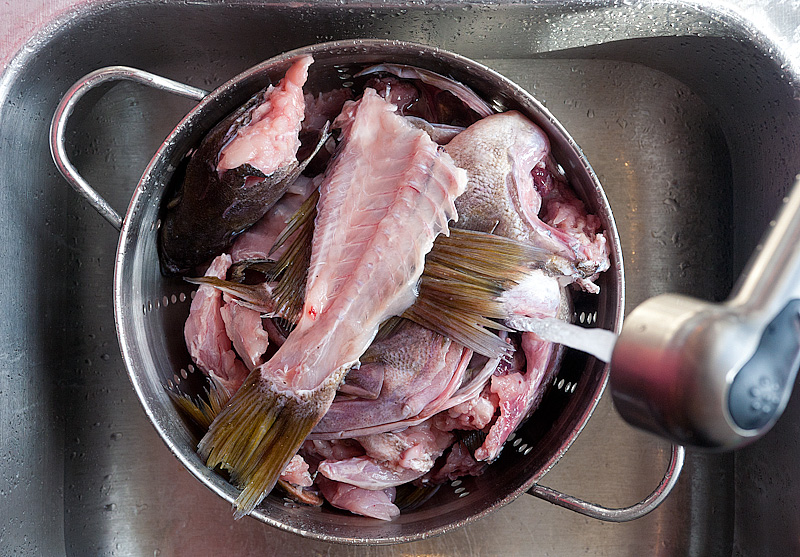
I only used about 1/3 of the carcasses to make this, so used the rest to make a water-based fish stock to just keep in the freezer. I love making my own stock, it’s so interesting; both of these stocks were rich in gelatin and set into a jiggly concoction when cooled…an indication of how much gelatin they contain.
The cream-based “mousse base” was strained and heated with more Agar, then blended with the poached liver into a smooth puree. This puree was left to set in the fridge for several hours until it was firm. I then cut it into cubes and pureed it again, strained it again, and had a lovely “liver mousse” that tasted sort of like a mix of seawater, foie gras, and clam chowder. It’s a pretty powerful flavor, but quite tasty and luxurious.
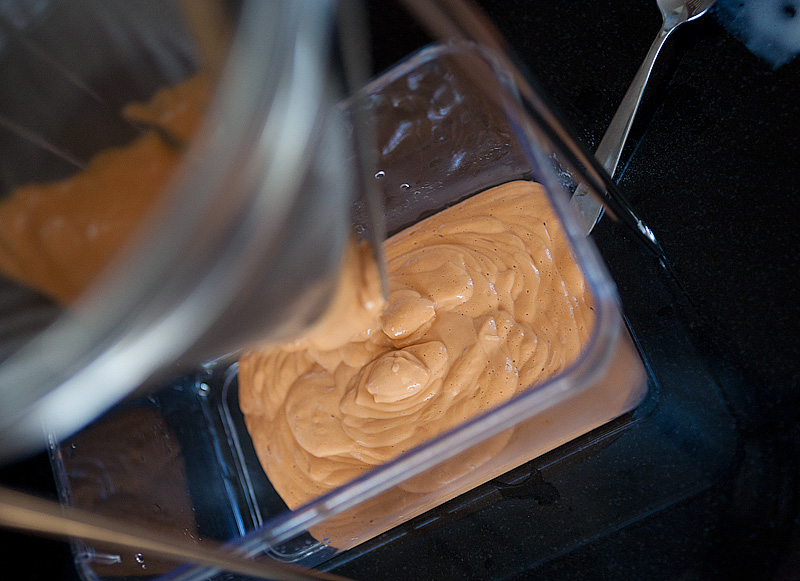
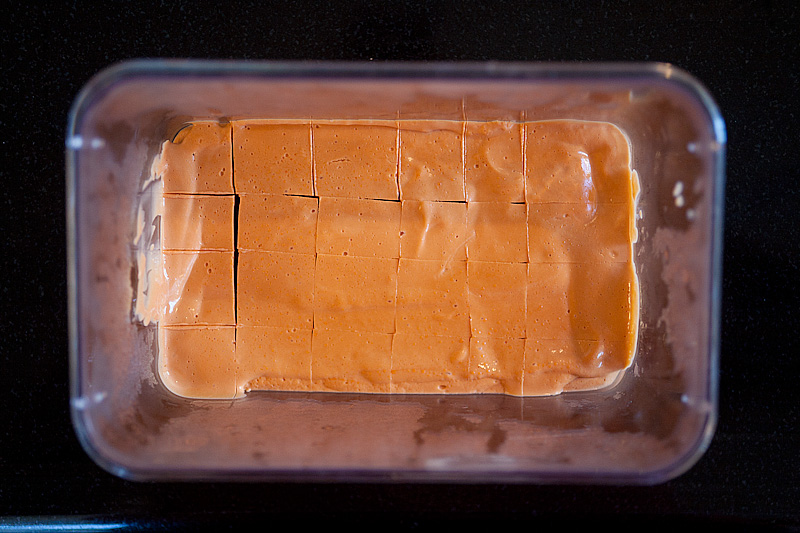
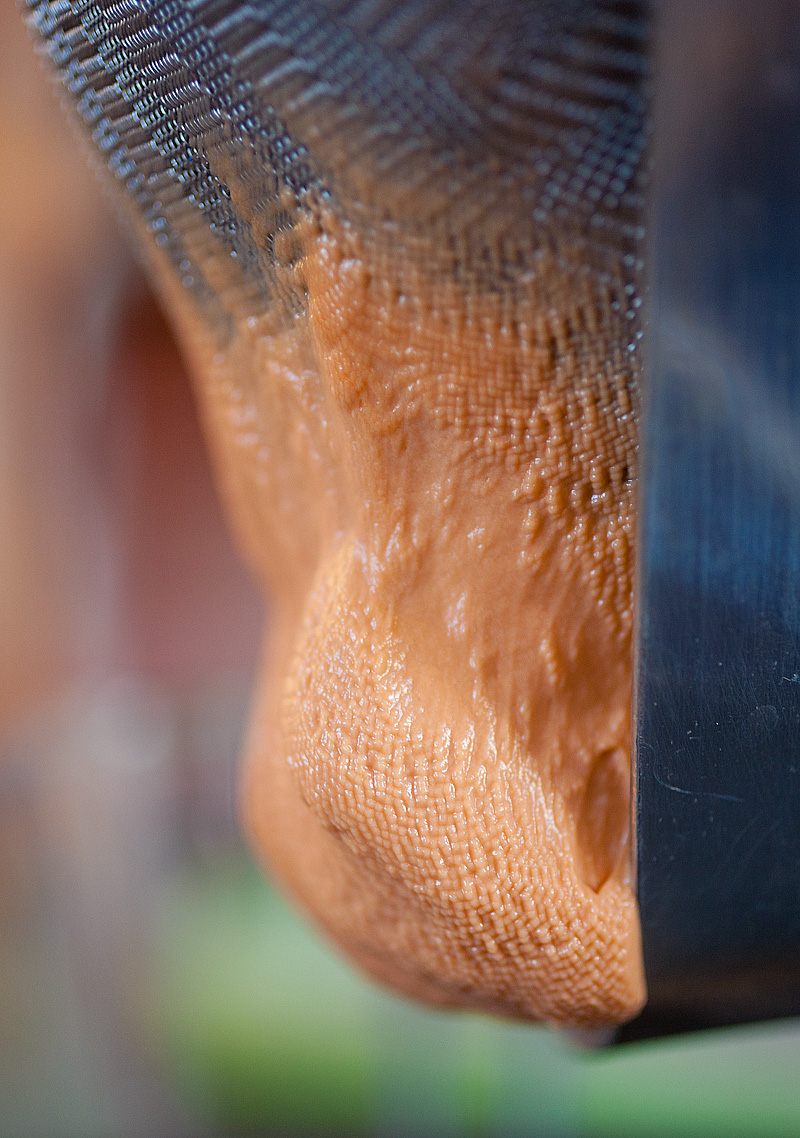
I couldn’t figure out how to shoot this moment and NOT have it look like a pair of shiny testicles, but at the same time I thought it was so interesting.
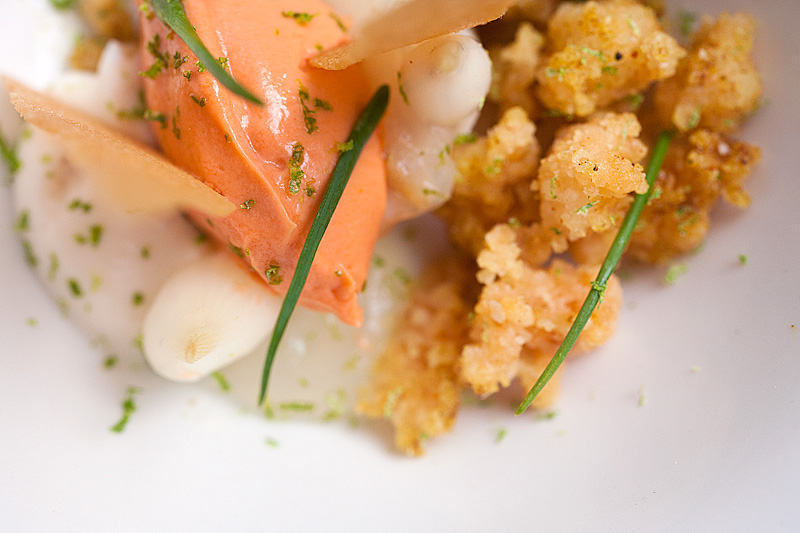
The final steps involved actually cooking the reserved monkfish loin in preparation for service. One of the loins was ground in a meat grinder to yield ‘monkfish hamburger’; this was tossed with cornstarch and deep-fried into crispy, fishy monkfish ‘popcorn’ of sorts. Alinea-style Long John Silver here. These were seasoned with a mixture of curry powder and salt, and were by far my and Sarah’s favorite element of this dish.
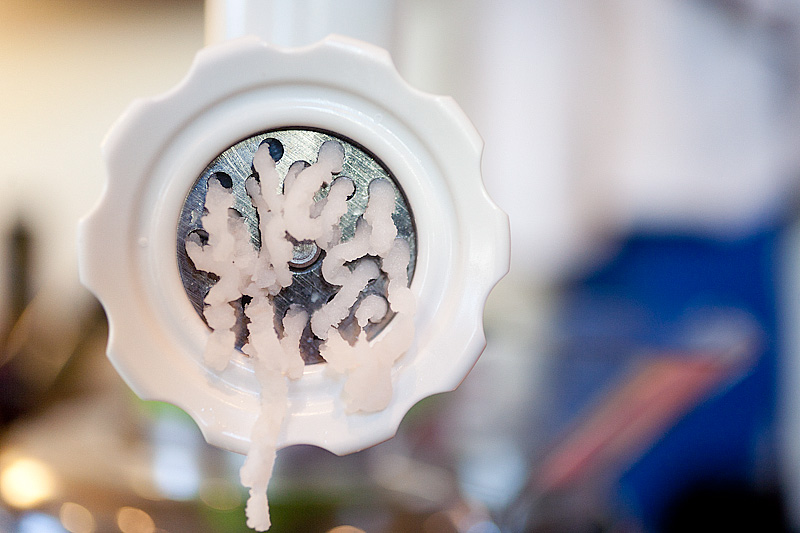
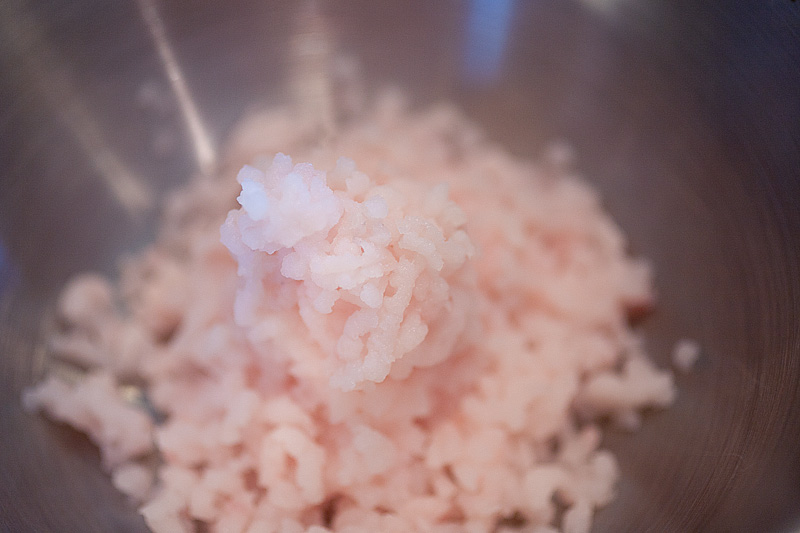
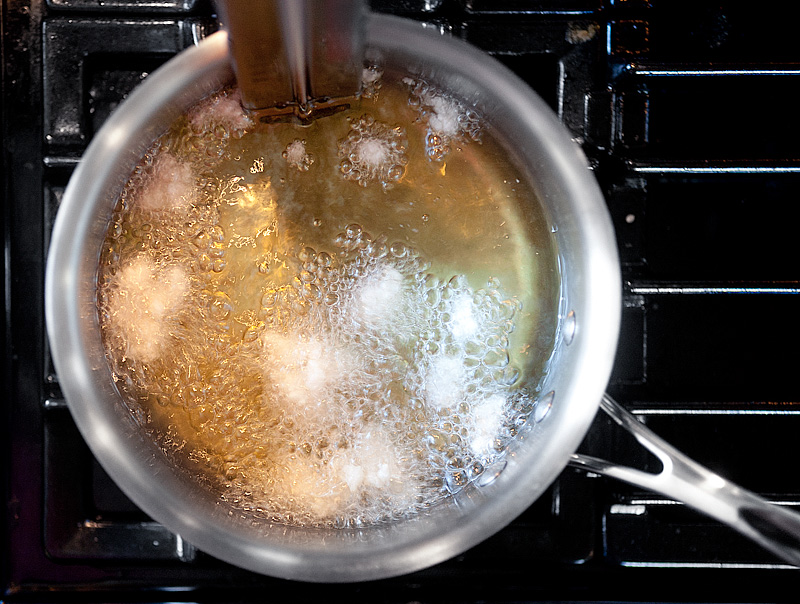
The other loin was cooked en sous vide with the Aromatic Butter, then cut into small portions for plating. The whole assembly was garnished with lime zest.
If you’ve chosen this as your ending point, I’ll conclude by saying all these flavors worked very well together; the lime flavors add a lovely brightness to the heavy seafood flavors and help keep the dish balanced. I loved the depth and complexity of the caramelized onion chips; I could eat those things on their own all day long (and did). The banana was muted for me in the face of all the other flavors, and I can’t understand why Alinea wouldn’t just puree a banana with cream rather than trying to infuse it with dried chips. As for the liver and monkfish itself, I can see why some call it “poor man’s lobster”; it has a buttery texture and soft, briny flavor, and the liver really is reminiscent of the luxury of foie gras, just ‘seawaterier’.
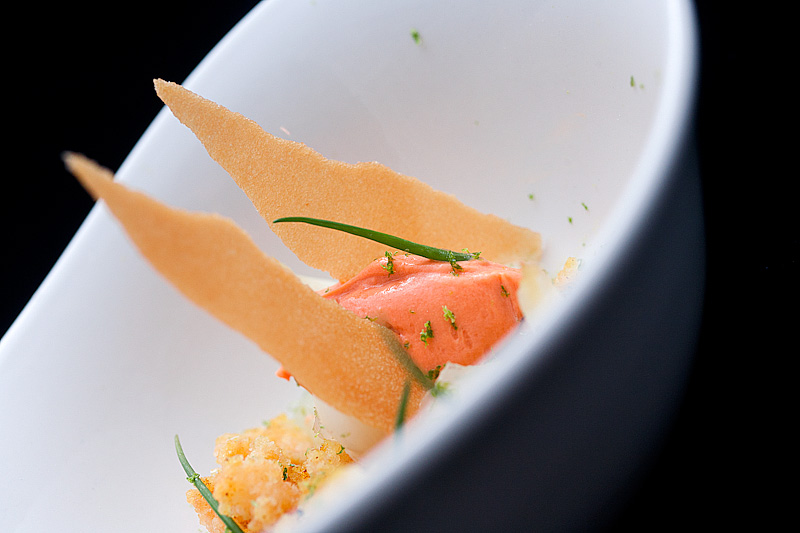
I read the account of this dish with the, uh, freakier details. Wow!! I’m in no position to comment on the food-safety aspects of what you decided to do, but I admire your persistence and resolve. I’m pretty sure that in the face of something like this I would have just said, “Fuck it,” and given up on the dish. (Invertebrates of all stripes just gross me out.)
But on the bright side, this dish does look really beautiful, and monkfish popcorn sound amazing!
It’s really not just monkfish that has that…hmm…problem Allen. Lots of fish do, probably some more than others. I think what you did was perfectly fine and above and beyond what would make the meat safe. In restaurants, I believe cooking the fish sous vide to a certain temp and holding it there will make the meat safe (there are plenty of resources online for such holding temps and in books like Modernist Cuisine). It’s gross thinking about what our fillet of sea bass might have had at one point though…no matter how pretty it looks now. I’ve seen these things up close and personal in black drum I’ve fished and you typically cut them off and go about your business of cooking and consuming the meat.
Lovely dish as always and kudos for the detailed and thorough reporting.